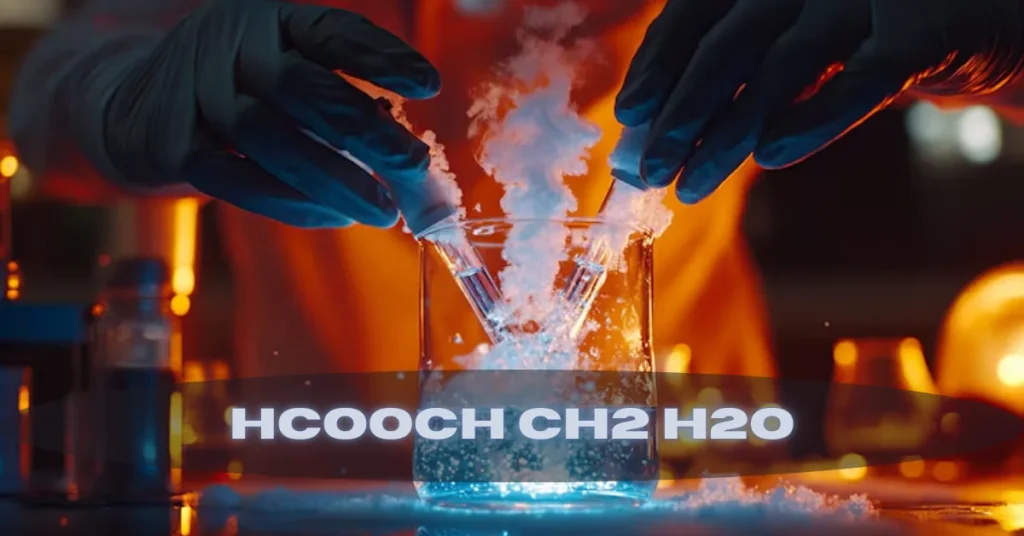Introduction
Have you ever wondered how some tiny molecules have an outsized impact on the world of hcooch ch2 h2o chemistry? Three such molecules—formic acid (HCOOH), methylene (CH2), and water (H2O)—are the unsung heroes of countless chemical reactions and innovations. Despite their simplicity, they form the backbone of many processes that power industries, laboratories, and even life itself.
This article dives into why these three are considered cornerstones of chemistry. We’ll explore their unique properties, their pivotal roles in different fields, and how they interact to unlock new possibilities. So buckle up, and let’s embark on a journey through the world of these fundamental molecules.
Understanding Formic Acid (HCOOH)
Formic acid hcooch ch2 h2o might sound exotic, but it’s surprisingly common. It’s the simplest carboxylic acid, with the formula HCOOH, and it naturally occurs in ant venom—hence its name (from formica, Latin for ant).
Natural Occurrence and Industrial Relevance
Formic acid is not just a biological curiosity; it’s produced industrially in large quantities. It’s used as a preservative, antibacterial agent, and a starting material for various chemical syntheses. Its ability to donate protons and act as a mild acid makes it versatile.
Chemical Properties and Reactions
What makes formic acid special is its dual nature: it can behave as an acid or a reducing agent. This flexibility allows it to participate in many reactions, such as:
- Decomposition to carbon monoxide and water under heat
- Acting as a hydrogen donor in reduction reactions
The Role of Formic Acid in Organic Chemistry
In organic synthesis, formic acid is a valuable reagent.
Use as a Reducing Agent
It can help reduce metal ions or organic compounds gently, making it useful in delicate reactions where harsher agents could ruin the product.
Formylation Reactions
Formic acid provides the formyl group (-CHO), essential in producing various formylated compounds used in pharmaceuticals and dyes.
Applications in Synthesis
From making esters to amides, formic acid is often a key player in building complex molecules.
Methylene (CH2) – The Reactive Intermediate
Methylene might not hang out in your kitchen, but it’s a superstar in the lab. This molecule exists as a carbene, a species with two electrons available for bonding, which makes it highly reactive.
Defining Methylene and Its Structure
Methylene exists in two states: singlet (paired electrons) and triplet (unpaired electrons). Both are fleeting but essential in many organic reactions.
Reactivity and Importance in Organic Transformations
Because of its high reactivity, methylene can insert into bonds, open rings, or create new ones, enabling chemists to build complex structures.
Methylene in Chemical Innovation
Carbene Chemistry Basics
Carbenes like methylene have revolutionized synthetic chemistry by enabling reactions that were once impossible or too slow.
Synthetic Applications
Methylene is used to create cyclopropanes—three-membered carbon rings—important in pharmaceuticals and agrochemicals.
Role in Polymerization and Material Science
It also helps generate new polymers with unique properties, driving innovation in materials.
Water (H2O) – The Universal Solvent
No chemistry discussion is complete without water. This tiny molecule’s unique properties make it the solvent of choice in labs and nature alike.
Unique Properties of Water
Water’s polarity, hydrogen bonding, and high heat capacity enable it to dissolve a wide range of substances and stabilize reaction intermediates.
Water’s Role in Chemical Reactions
Water is not just a medium—it can participate directly, hydrolyzing bonds or facilitating proton transfers.
Water in Green Chemistry and Sustainability
Water as a Reaction Medium
Water’s non-toxic, abundant nature makes it a prime candidate for eco-friendly chemistry, replacing harmful organic solvents.
Environmental Advantages
Using water reduces hazardous waste and energy consumption.
Water in Catalysis and Biochemical Processes
It’s crucial for enzymes and catalysts, bridging biological and synthetic chemistry.
Interactions Between Formic Acid, Methylene, and Water
These molecules don’t just work solo. Their chemistry intertwines beautifully.
Chemical Interplay in Reactions
For instance, water can stabilize reactive methylene intermediates, while formic acid can serve as a proton source or reducing agent in aqueous media.
Examples of Combined Use in Innovation
Formic acid in water is used in hydrogen storage research, while methylene chemistry benefits from water’s solvation effects.
Industrial and Practical Applications
Formic Acid in Textiles and Leather Industry
It’s used to treat fabrics and leather, improving quality and durability.
Methylene in Advanced Materials
In polymers and coatings, methylene-derived compounds enhance performance.
Water in Pharmaceuticals and Biotechnology
Water’s ubiquity in drug formulation and biotech processes is unmatched.
Recent Advances and Research Trends
Cutting-edge research focuses on harnessing these molecules for greener, more efficient chemistry.
New Catalytic Methods
Researchers are developing catalysts that use formic acid and methylene to reduce environmental impact.
Sustainable Chemistry Developments
Water-based processes are growing rapidly in industrial chemistry.
Future Prospects
With advances in molecular design, these molecules will continue driving chemical innovation.
Challenges and Considerations
Handling Reactivity and Stability
Methylene’s extreme reactivity requires careful control.
Environmental and Safety Aspects
Formic acid must be handled safely due to its corrosiveness.
Scale-up and Industrial Implementation
Bringing lab successes to industrial scale remains challenging but promising.
Conclusion
Formic acid, hcooch ch2 h2o methylene, and water—simple molecules with mighty powers—are true cornerstones of chemistry. Their unique properties, versatile roles, and interplay fuel innovations that touch everything from medicine to materials to sustainability. Understanding and leveraging these molecules help scientists and industries push the boundaries of what’s possible, making chemistry not just a science but a creative adventure.






